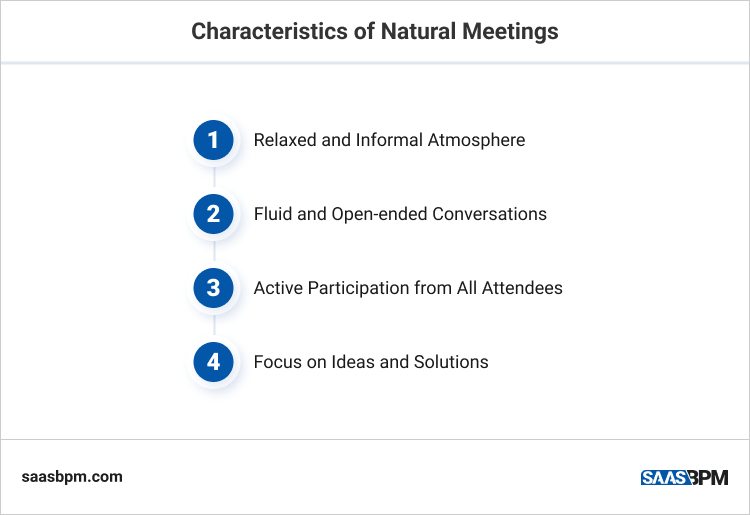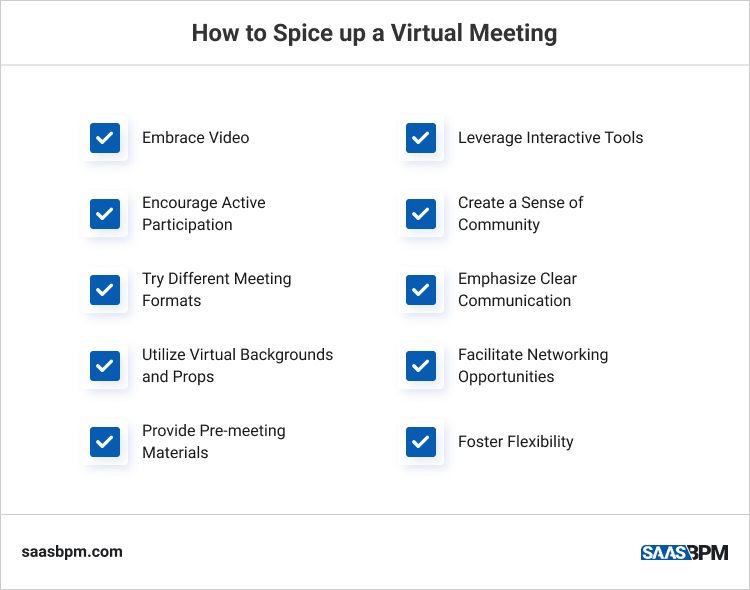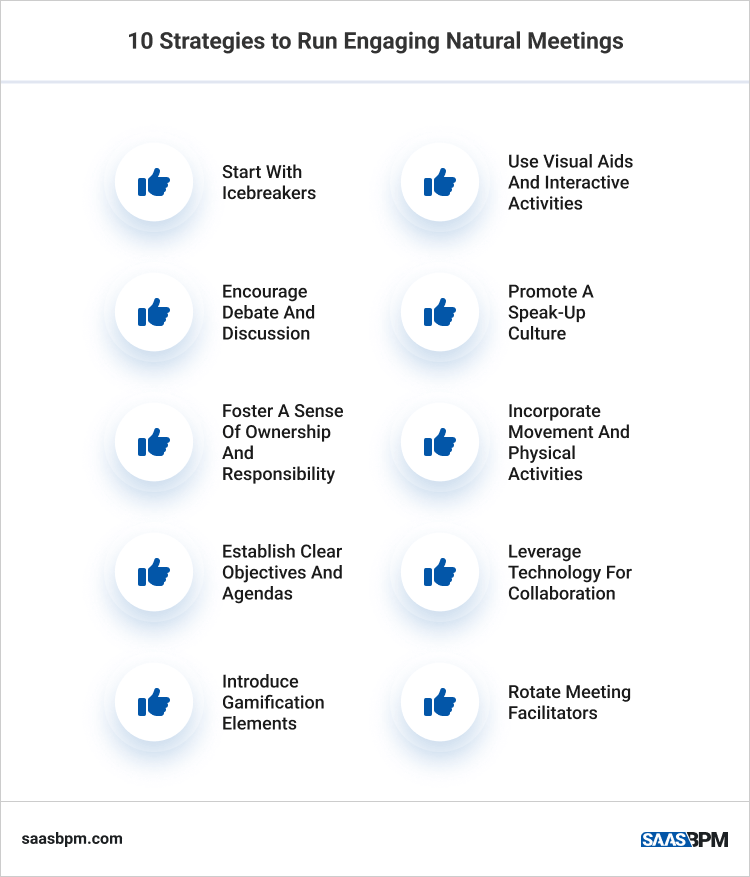When we discuss workplace dynamics, the paradigm of meetings is undergoing a transformative shift towards “natural meetings.” Diverging from traditional, structured formats, natural meetings thrive in a relaxed and open environment, giving way to creativity, collaboration, and engagement.
Unlike their formal counterparts, these gatherings prioritize the free flow of ideas over rigid structures, fostering an atmosphere where every participant feels heard. The benefits are substantial – heightened creativity, strengthened collaboration, and increased engagement.
As organizations navigate the changing landscape of work structures, understanding and embracing the essence of natural meetings becomes not just a trend. Research shows that 71% of employees find meetings to be a waste of time. Thus, finding a way to make them more effective is a must.
In this article, we will describe what natural meetings are and share some tell-tale signs that a meeting is going well. Also, we will outline a few tips about effective virtual meetings in particular. We will then go through ten successful strategies to run natural meetings in your company.
Natural Meetings Characteristics: Know the Signs

Efficiency and productivity in meetings hinge on recognizing key characteristics that define natural and engaging sessions. In contrast to traditional structures, natural meetings cultivate an environment marked by informality, fluidity, and inclusivity.
Relaxed and Informal Atmosphere
Natural meetings often unfold in a relaxed setting, devoid of excessive formality. The atmosphere is conducive to open dialogue, encouraging team members to express themselves freely. Recognizing this informality is a key sign that a meeting is taking on a more natural tone.
Fluid and Open-ended Conversations
Unlike structured meetings with fixed agendas, natural meetings embrace fluid and open-ended conversations. Discussions meander organically, allowing for unexpected insights and collaborative idea generation. If conversations evolve spontaneously and explore various facets of a topic, the meeting is embodying natural characteristics.
Active Participation from All Attendees
In natural meetings, every attendee actively contributes to the discourse. This inclusivity fosters a sense of ownership among participants, making them feel valued and engaged. Observing consistent and enthusiastic participation from all members indicates the presence of a natural meeting environment.
Focus on Ideas and Solutions
Rather than adhering to rigid hierarchies or status-driven discussions, natural meetings center around ideas and solutions. Team members collaborate to solve challenges, emphasizing collective problem-solving. A shift towards discussing solutions and fostering creativity is a clear sign that a meeting is adopting a more natural approach.
4 Steps To Recognize When a Meeting is Becoming More Natural
- Observing Eased Body Language.Natural meetings are characterized by relaxed body language. If participants appear comfortable, leaning in, and engaging in non-verbal cues, the meeting is likely taking on a more natural form.
- Spontaneous Brainstorming.Watch for spontaneous brainstorming sessions. If ideas flow freely and participants build upon each other’s contributions without strict adherence to an agenda, the meeting is evolving naturally.
- Inclusive Participation.Actively observe the level of participation. A natural meeting encourages input from all members, irrespective of their roles or positions within the organization.
- Focus on Solutions, Not Hierarchy.Listen for a shift in focus towards solutions rather than hierarchical discussions. If the conversation centers on resolving challenges and fostering a collaborative environment, the meeting is transitioning towards a more natural structure.
How to Spice up a Virtual Meeting

Virtual meetings, while essential for remote collaboration, often face challenges in maintaining engagement and interactivity. Although 70% of employees find remote work catchups to be less stressful, still 95% of the participants do not pay attention and multitask during them. However, by employing creative strategies, these virtual sessions can be transformed into dynamic and engaging experiences.
Embrace Video
Utilize video conferencing platforms to foster a more personal connection. Seeing faces adds a human touch, bridging the physical gap inherent in virtual interactions. Encourage participants to turn on their cameras to create a sense of presence and connection.
Leverage Interactive Tools
Incorporate interactive tools to break the monotony of screen sharing. Platforms offer features like polls, surveys, and collaborative whiteboards. These tools not only keep participants actively involved but also provide valuable insights and foster real-time collaboration.
Encourage Active Participation
Establish a culture of active participation by encouraging input from all attendees. This can be achieved through techniques such as asking open-ended questions, initiating discussions, or utilizing breakout rooms for smaller group interactions. Actively involving participants prevents virtual meetings from becoming passive experiences.
Create a Sense of Community
Despite physical distance, virtual meetings can cultivate a sense of community. Begin sessions with brief personal check-ins or icebreakers. Recognize achievements or milestones, fostering camaraderie. Virtual environments, when infused with elements of community-building, become more engaging and enjoyable.
Try Different Meeting Formats
Break the routine by varying meeting formats. Consider incorporating shorter, focused sessions or introducing themed meetings. Experimenting with different structures prevents virtual gatherings from becoming predictable and keeps participants attentive.
Emphasize Clear Communication
Effective communication is paramount in virtual settings. Clearly outline meeting objectives, agendas, and expectations in advance. This ensures that participants come prepared, contributing to a more productive and engaging session.
Utilize Virtual Backgrounds and Props
Harness the fun elements of virtual platforms by encouraging participants to use virtual backgrounds or props. This adds an element of creativity and can lighten the atmosphere, making the meeting more enjoyable.
Facilitate Networking Opportunities
Incorporate virtual networking opportunities within meetings. This could include brief discussion periods or designated time for team members to connect on a personal level. Nurturing connections enhances overall engagement and contributes to a more cohesive team dynamic.
Provide Pre-meeting Materials
To streamline discussions, provide pre-meeting materials such as documents, articles, or relevant resources. This allows participants to familiarize themselves with the topics beforehand, enabling more meaningful contributions during the meeting.
Foster Flexibility
Acknowledge the challenges of virtual environments and embrace flexibility. Understand that technical glitches or distractions may occur. A more forgiving and adaptable approach contributes to a positive virtual meeting experience.
10 Strategies to Run Engaging Natural Meetings

Running natural meetings that spark creativity and engagement involves adopting strategies that go beyond the traditional meeting structures. Here’s a comprehensive list of 10 effective strategies for cultivating interactive and engaging meetings:
1. Start with Icebreakers
Set the tone for a relaxed and inclusive meeting by incorporating icebreakers. These activities promote camaraderie, encourage team members to share personal anecdotes, and create a positive atmosphere. Whether it’s a quick round of introductions or a fun question of the day, icebreakers foster a sense of connection.
2. Use Visual Aids and Interactive Activities
Enhance engagement by integrating visual aids and interactive activities. Utilize slides, charts, or graphs to convey information visually. Introduce interactive activities like brainstorming sessions, virtual scavenger hunts, or collaborative exercises that stimulate creative thinking. Visual and interactive elements capture attention and maintain participant focus.
3. Encourage Debate and Discussion
Foster a culture of healthy debate and discussion within the meeting space. Encourage team members to express diverse opinions and viewpoints. By embracing different perspectives, natural meetings become breeding grounds for innovative ideas. Create an environment where constructive debates contribute to the collective intelligence of the team.
4. Promote a Speak-Up Culture
Establish an inclusive atmosphere that promotes a speak-up culture. Encourage team members to voice their thoughts and opinions without fear of judgment. This inclusive approach ensures that every participant feels valued and contributes to the ongoing dialogue. Actively seek input from all members to harness the collective intelligence of the team.
5. Foster a Sense of Ownership and Responsibility
Instill a sense of ownership and responsibility among meeting attendees. When team members feel a personal connection to the outcomes of the meeting, they become more invested in the discussions. Assign tasks or responsibilities to individuals, allowing them to take ownership of specific aspects. This sense of accountability nurtures engagement and commitment to meeting objectives.
6. Incorporate Movement and Physical Activities
Combat meeting fatigue by incorporating movement and physical activities. Encourage short breaks for stretching or light exercises. Virtual meetings can benefit from brief movement sessions or incorporating energizing activities like quick virtual games. Movement not only rejuvenates participants but also contributes to a more dynamic meeting environment.
7. Establish Clear Objectives and Agendas

Ensure clarity by establishing clear meeting objectives and agendas. Communicate the purpose of the meeting beforehand, allowing participants to prepare and contribute meaningfully. A well-defined agenda sets expectations and provides structure, guiding discussions toward productive outcomes.
8. Leverage Technology for Collaboration
Harness collaborative tools and technologies that facilitate real-time interaction. Platforms offering features like shared documents, virtual whiteboards, and collaborative editing enable seamless teamwork. Leveraging technology enhances the interactive nature of the meeting, allowing participants to co-create and contribute actively. In addition, use software to transcribe audio to text, streamlining the process of capturing discussions and ensuring accurate documentation of meeting outcomes.
9. Introduce Gamification Elements
Infuse elements of gamification into meetings to make them more engaging. Consider incorporating quizzes, challenges, or team-based competitions that align with meeting objectives. Gamification adds an element of fun and competition, fostering a lively and participatory atmosphere.
10. Rotate Meeting Facilitators
Promote shared leadership and diverse perspectives by rotating meeting facilitators. Allowing different team members to lead meetings introduces fresh styles and approaches. This strategy not only empowers team members but also contributes to a more collaborative and inclusive meeting culture.
Final Thoughts
Embracing natural meetings is paramount for fostering workplace creativity, collaboration, and engagement. A cultural shift towards organic, dynamic meeting styles prioritizes idea generation and participation over hierarchy and formality. By cultivating an atmosphere where every voice is heard, ideas flow freely, and participants actively contribute, organizations unlock the full potential of their teams. It’s not just about meetings; it’s about shaping a collaborative culture where innovation thrives. In a world where ideas fuel progress, adopting the ethos of natural meetings becomes a strategic imperative for organizations seeking to stay agile, creative, and connected.

